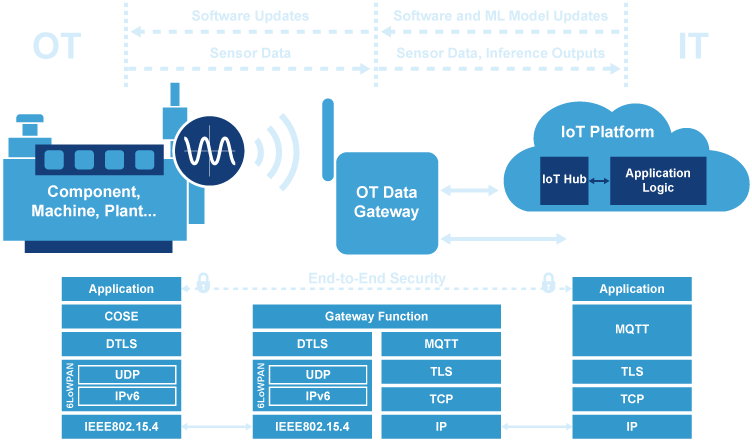Contact · Newsletter · DEUTSCH

Data-based solutions in the environment of machines and plants require various hardware and software modules. In addition to embedded systems for raw data acquisition, special gateway and cloud functions are required. Two particular areas of focus are AI-based data analysis (machine learning) and cybersecurity. The WSEI/154A technology stack was developed for these kinds of multidisciplinary tasks. It covers the entire range of tasks from sensors to automatic decision-making.
The WSEI/154A is based on wireless sensors using the IEEE802.15.4 standard at 868 and 915 MHz respectively, and is structured into the three subsections sensing endpoint, gateway and IoT platform (cloud).
For each of these subsections, the WSEI/154A offers pre-developed and tested functions that have been coordinated and optimized with each other.

Edge Intelligence refers to methods to analyze larger data volumes with the help of AI no longer centrally in the cloud, but directly on site at the edge between OT (operation technology) and IT (information technology) – thus exactly where the data is actually created in industrial sensor applications.
This has many advantages in terms of data security as well as typical bandwidth, latency and availability issues of a sensor-to-cloud connection. However, this also creates some new challenges, the complexity of which should not be underestimated.
One of these is that in decentralized AI deployment (e.g. artificial neural networks with TensorFlow and TensorFlowLite), model generation and model use (inference) are no longer done on the same hardware and software platform.
Instead, while models are generated in the cloud, the inference is done at the edge. Another challenge is the remote update capability of machine learning models at the edge and the IT related security aspects.
The WSEI/154A technology stack is therefore by no means "just" another "sensor-to-cloud" solution for IoT projects.
The WSEI/154A offers much more, in addition to connectivity, the required AI or machine learning components with adaptive mathematical models, which enable completely automated decision making processes based on real-time sensor data,
e.g. in logistics and production environments, as well as heating, ventilation and air conditioning technology (HVAC) or in decentralized energy systems.
For that, the WSEI/154A uses artificial neural networks with TensorFlow and TinyML, among others.
To keep WSEI/154A functions up to date in practice and to adapt cybersecurity to changing conditions as needed, Secure Device Update (SDU) functions are part of the technology stack.
They allow highly secure, yet simple OTA updates for the sensing and gateway functions.

The center of an SDU application is a dedicated server that is delivered as a docker container and operated on-prem or as a cloud service.
Using a signing tool (the SDU signing tool) the update files are combined into one object and transferred to the server together with a manifest.
From there, the download to the target devices – the sensors and gateways of a WSEI/154A application – takes place.
The entire update process is secured via an end-to-end PKI with public and private keys and X.509 certificates.
To receive further technical information, please fill in the form. If you have any further questions, please contact our sales department directly.
Telefon: +49 (0)511 · 40 000-34
E-Mail: sales@ssv-embedded.de
Please fill in the whole form.
SSV SOFTWARE SYSTEMS
Dünenweg 5
30419 Hannover
Phone: +49(0)511 · 40 000-0
Fax: +49(0)511 · 40 000-40
© 2025 SSV SOFTWARE SYSTEMS GmbH // All rights reserved.
ISO 9001:2015